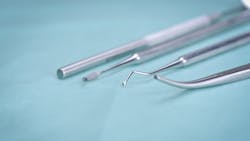In the dental field, the quality of maintained instruments has a direct effect on patients' comfort, care, and systemic health. When attempting to work with dull and worn hygiene instruments, patient discomfort will inevitably become an issue. For these reasons and more, the maintenance of dental hand instruments should be one of the most important parts of a clinician’s daily work routine.
Why don’t clinicians make sharpening a priority?
Many dental professionals don’t add maintenance to their daily schedule or simply lack the time to adequately sharpen their instruments throughout the workday. Others may lack confidence in their instrument-sharpening skills. Some even claim that their practice owner is against them sharpening too frequently because the instruments will wear out more quickly. Nothing could be further from the truth, especially knowing how beneficial a sharp instrument can be.
You may also be interested in …
Ask OSAP: What’s the best workflow for instrument processing?
A sterilization labeling and logging solution
The cutting edges of scalers will begin to dull after just one patient, making regular instrument maintenance critical. As few as 15–45 scaling strokes can dull a instrument. The objective of sharpening is to reestablish the fine line of the cutting edge and maintain the original shape of the blade.1 This will increase tactile sensitivity and make the instrument last longer. Each instrument comes with a clear purpose and goal.
Consequences of working with dull instruments
In a recent study, one out of eight dental hygienists felt emotionally exhausted from work.2 Factors associated with work stress are musculoskeletal pain, balancing work and personal life, the demand for highly efficient work, long working hours, working without assistance, difficult or demanding patients, lack of leisure time, lack of practice management support, and doubts about one’s own capabilities. While these contributors are relatable for most clinicians, many may not realize their relationship with using dull instruments. After each patient, it becomes even more critical to sharpen and inspect instruments to make sure they will continue to work effectively.
Fatigue can come in many different forms and set in when one least expects it. Dental hygiene is physically demanding in a way that can cause musculoskeletal problems (carpal tunnel syndrome and cubital tunnel syndrome, for example).3 This is due to repetitive motions, incorrect posture, and dull instruments. One way to lessen these physical demands is to maintain the proper cutting edges of hygiene instruments. When practice owners don’t see this as a necessity, hygienists may find themselves not only educating patients about oral care but also explaining the importance of instrument maintenance to their bosses. Dentists must realize the significant benefits of taking time to sharpen instruments or hiring a professional to keep their instruments in top-notch condition.
How to enhance your sharpening skills
Many continuing education courses are available to teach clinicians how to enhance their sharpening skills. For dental hygienists in the clinical setting who don’t have time to sharpen instruments during the day (or simply don’t have the desire to), there are services available for hire to manage this important task. Sharpening specialists can allow clinicians to keep working without sacrificing their comfort level or skimping on the quality of patient care.
Instruments are not made to last forever. Keeping them sharp increases their longevity, but that doesn’t mean they won’t eventually lose their cutting edge. After using scalers for an extensive period or having gone an excessive amount of time without sharpening, they’ll need to be replaced. Being intentional about maintaining sharp instruments will increase your productivity, decrease aches and pains, and yield healthier, happier clinicians.
Editor’s note: This article first appeared in Through the Loupes newsletter, a publication of the Endeavor Business Media Dental Group. Read more articles and subscribe to Through the Loupes.
References
- Smith D. Maintain the cutting edge of dental instruments. Dimens Dent Hyg. 2018;16(2):24, 26-28. https://dimensionsofdentalhygiene.com/article/maintain-the-cutting-edge-of-dental-instruments/
- Gorter RC. Work stress and burnout among dental hygienists. Int J Dent Hyg. 2005;3(2):88-92. doi:10.1111/j.1601-5037.2005.00130.x
- Attari S. The physical challenges of being a dental hygienist. DentistryIQ. October 22, 2019. https://www.dentistryiq.com/dental-hygiene/ergonomics/article/14069153/the-physical-challenges-of-being-a-dental-hygienist
About the Author
Sarabeth Ballard, RDH
Sarabeth Ballard, RDH, has been in the dental field for 20 years. She is the president of the Greater Fort Worth Dental Hygienists’ Association and a working clinical hygienist. She owns and operates Sharpen Your Edge, a company that offers nationwide instrument sharpening services with honesty, integrity, and promptness. Sarabeth has a passion for improving the career longevity of dental hygienists and supporting busy practices with their sharpening needs. Contact her at [email protected] or sharpenyouredge.us.
Updated February 27, 2023


